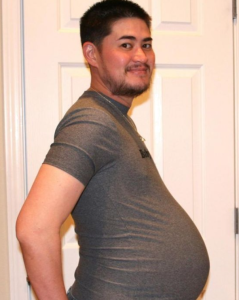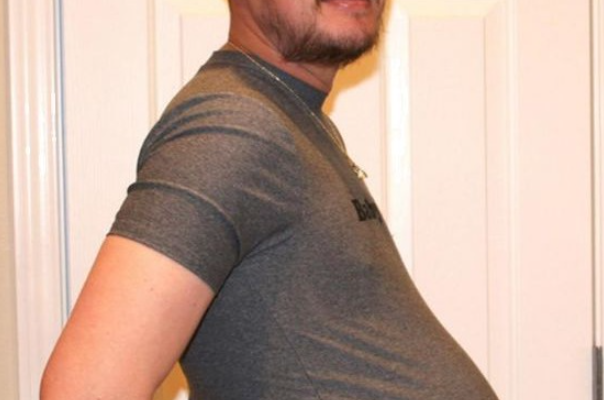First Man in the World to Give Birth – Here He Is, 16 Years Later
Sixteen years ago, the world was stunned when headlines announced something that many believed impossible: a man had given birth. The story spread across every corner of the globe, igniting debates about science, gender, identity, and the limits of human possibility. That man was Thomas Beatie, a transgender pioneer who carried and delivered a child while living openly as male. Now, more than a decade and a half later, his journey continues to captivate, inspire, and challenge the way society thinks about family.
Breaking the Impossible
Back in 2008, Thomas Beatie—an American trans man—made international news when it was revealed that he was pregnant. Born female, Beatie had transitioned medically and legally into life as a man but chose to retain his female reproductive organs. When his wife at the time was unable to conceive, Beatie made the decision to carry the pregnancy himself.
The images of a bearded man with a visibly pregnant belly circulated rapidly, sparking astonishment and controversy. Some viewed it as groundbreaking and courageous, while others ridiculed and criticized it. Yet the reality remained undeniable: Thomas Beatie became the first man in recorded history to give birth.
The Birth That Shocked the World
In June 2008, Beatie successfully delivered his first child, a healthy baby girl. That moment marked a turning point in conversations about gender, family, and reproductive rights. He would go on to give birth to two more children, each time reminding the world that traditional definitions of parenthood were evolving.
For Beatie, it wasn’t about publicity or shock value—it was about the deep human desire to have a family. In interviews, he explained that fatherhood and motherhood were labels society placed on people, but at the heart of it, parenting was about love, responsibility, and sacrifice.
The Aftermath: Fame, Scrutiny, and Struggles
The media frenzy around Beatie’s pregnancies was overwhelming. Talk shows, magazines, and news outlets couldn’t get enough of the story. He was invited on programs like Oprah to explain his journey, often facing deeply personal and invasive questions about his body and choices.
The public reaction was split down the middle. Some praised him as a trailblazer, while others condemned him. Online forums exploded with debates, often cruel, about whether he was “really” a man, whether his children would suffer, and what it all meant for society.
Beatie himself admitted that the scrutiny was difficult. His marriage, which had initially been a source of support, eventually crumbled under the weight of the pressure and personal challenges. He went through a painful divorce, a custody battle for his children, and years of being under the harsh spotlight of judgment.
Sixteen Years Later: Where Is He Now?
Today, Thomas Beatie is 50 years old, and the story of his life looks very different from the sensational headlines of 2008. He is no longer just “the pregnant man”—he is a devoted father raising three teenagers who are finding their own way in the world.
The children he once carried are now young adults and adolescents. They are pursuing education, hobbies, and dreams just like any other kids. Beatie has often spoken about how proud he is of them, emphasizing that his main goal was always to give them a stable, loving upbringing, even if their origin story made them the focus of public fascination.
Beatie himself has continued his advocacy work, speaking at universities, conferences, and LGBTQ+ events. His message is consistent: family is about love, not about rigid definitions of gender or tradition. He stresses that he never set out to be a symbol—he simply wanted to be a parent. Yet by living openly, he became an accidental pioneer.
The Legacy of His Decision
Looking back sixteen years, it’s clear that Beatie’s decision had a profound ripple effect. His story paved the way for wider discussions on transgender parenthood, reproductive rights, and what it truly means to be a family.
In the years since his first pregnancy, other transgender men have followed a similar path. Though still rare, the concept of trans men carrying children has become less shocking, in part because Beatie’s public journey broke that barrier.
Medical communities, legal systems, and even schools have had to adjust to new realities, ensuring that families like Beatie’s are treated with dignity and fairness.
The Human Side
For all the headlines, debates, and politics, Beatie’s story is, at its core, profoundly human. He was a person who longed to build a family and chose to endure criticism and difficulty in order to achieve it. His children, now teenagers, don’t see him as “the pregnant man”—to them, he is simply Dad.
This is perhaps the greatest testament to his journey: that beyond the spectacle, life goes on. Children grow, parents provide, and love endures.
The Man Behind the Headlines
Beatie has shared in recent years that he wants to move beyond being defined by that one chapter of his life. While grateful for the platform it gave him to speak on issues of equality and acceptance, he prefers to be known as a father, an advocate, and a human being rather than just a headline.
Still, he acknowledges the unique place he holds in history. “I’ll always be the first,” he has said in interviews, “but what matters most is that my kids know I love them and that I did everything I could to bring them into this world safely.”
A Reflection Sixteen Years On
The world of 2008 feels very different from the world of today. Conversations around gender identity and family structure, while still contentious, have advanced significantly. In many ways, society has caught up to what Beatie embodied all those years ago: that parenthood transcends rigid roles and definitions.
And yet, his story still has the power to provoke thought. It forces us to ask: Who gets to decide what makes someone a mother or a father? Is it biology, appearance, or love?
Sixteen years later, the answer remains as powerful as ever: families are built on love, commitment, and care.
Conclusion
Thomas Beatie’s story will always carry an element of shock for those who first remember seeing the images of a pregnant man. But as time has passed, the sensationalism has given way to something deeper: respect. Respect for his courage, for his resilience, and for his children, who are now living proof that his unconventional path to parenthood was no less real, no less valid, and no less beautiful.
Sixteen years later, the man once known as “the pregnant man” stands not as a curiosity, but as a father who did what he had to do for the sake of love.


